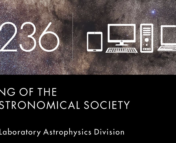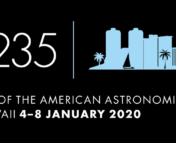In this series of posts, we sit down with a few of the keynote speakers of the 236th AAS meeting to learn more about them and their research. You can see a full schedule of their talks here, and read our other interviews here!
Writing Down a Symphony
Dr. Christy Tremonti was in grad school when she wrote one of the most influential papers of the 2000s. “I had four dead-end projects, and I was a fifth year student with no thesis,” says Tremonti. Then she started playing with some of the first data from the Sloan Digital Sky Survey, and she found a tight correlation between the mass of a galaxy’s stars and its metallicity (abundance of elements heavier than helium in the galaxy’s gas).
Tremonti’s 2004 paper on the “mass-metallicity relation” has since been cited thousands of times. That paper was just the start for Tremonti, though: “Once I had built the mass-metallicity relation plots,” she says, she started asking “what does it actually tell us? What can we learn from this correlation?” In particular, we now know that stellar feedback—energy and momentum injected by stars into the interstellar medium of a galaxy—is required to produce the observed shape mass-metallicity relation. As Tremonti explains, “you can’t even come close to doing things correctly unless you include feedback.”
Today, Tremonti is an assistant professor at the University of Wisconsin-Madison, continuing to study the role of feedback in galaxy evolution. Her work, she says, is like “listening to a symphony and being asked to write down the score for each instrument.” Like an individual instrument, feedback plays an important role in the overall symphony of galaxy evolution. But just as no instrument is alone in a symphony, “you can’t entirely think about feedback in isolation because so much else is going on.”
Galactic winds, not woodwinds
One of the biggest open questions regarding feedback is the observation of galactic winds: cold gas moving away from galaxies at staggeringly high velocities, on the order of thousands of kilometers per second. Star formation and the explosive deaths of young stars help drive these outflows, but as Tremonti describes, there are still many unanswered questions about how this happens. “How do we accelerate cold gas to these speeds without actually destroying it in the process? How are outflow properties connected to the properties of the host galaxy? Exactly how much material is ejected from galaxies?”
Tremonti and her group work to address some of these questions through a combination of indirect and direct observational approaches. “The chemical abundances of galaxies can serve as an indirect tracer” of galactic winds, says Tremonti, since gas outflows can expel heavy elements from a galaxy. “You’re seeing the impact of these winds, and you have to sort of tease apart the other things that are going on, like star formation and inflows,” since these can also affect chemical abundances.
In order to directly measure the properties of outflows, Tremonti’s group looks at extreme objects: compact starburst galaxies at slightly higher redshifts (z~0.5). “They’re just a really good test case for what’s the sort of ‘maximum oomph’ you can get from star formation-driven feedback,” Tremonti says. Because these galaxies are forming huge masses of stars in relatively small amounts of space, they’re able to produce “some of the fastest outflows we’ve ever observed from star-forming galaxies.”
Some positive feedback
How did Tremonti start studying astronomy in the first place? “I had a really kind of funny path,” she says. “I actually dropped taking physics after my first semester, thinking ‘Wow, I really love this stuff, but I’m just not cut out for it.’” A semester later, she ran into her former physics teacher. “He was like, ‘What happened to you? Come back!’” That positive feedback (pun definitely intended) helped convince her, and Tremonti decided to major in astronomy.
After not getting into grad school on her first try, she took a short break. “I took a year off and worked at a horse farm. It was definitely something very different,” she laughs. That experience helped solidify her interest in academia, and she re-applied for grad school.
As a grad student, Tremonti constantly tried new things. She and her cohort constantly proposed for observing time. “I don’t think I ever missed a Hubble deadline, despite not having an advisor or a project or anything. We were always cooking up ideas and submitting them.” She grins. “I’m not sure we were ever successful, but I think we taught ourselves a lot.” Similarly, although her research projects didn’t always go anywhere, “all four of my failed projects gave me a skill that ended up being really valuable later.”
Today, Tremonti encourages students to focus on building skill sets instead of building a publication list. One of the best things about being a student, after all, is “the ability to dig deep and just really try to understand a problem and put your complete focus on it.” And if you fail, that’s not so bad. “It’s easy in grad school to panic about a lost year or two,” she says, “but if you learn something it’s not truly lost.”
You’ll certainly learn something at Dr. Tremonti’s plenary talk, so come check it out at 4:30PM EDT on Wednesday, June 3 at #AAS236!


